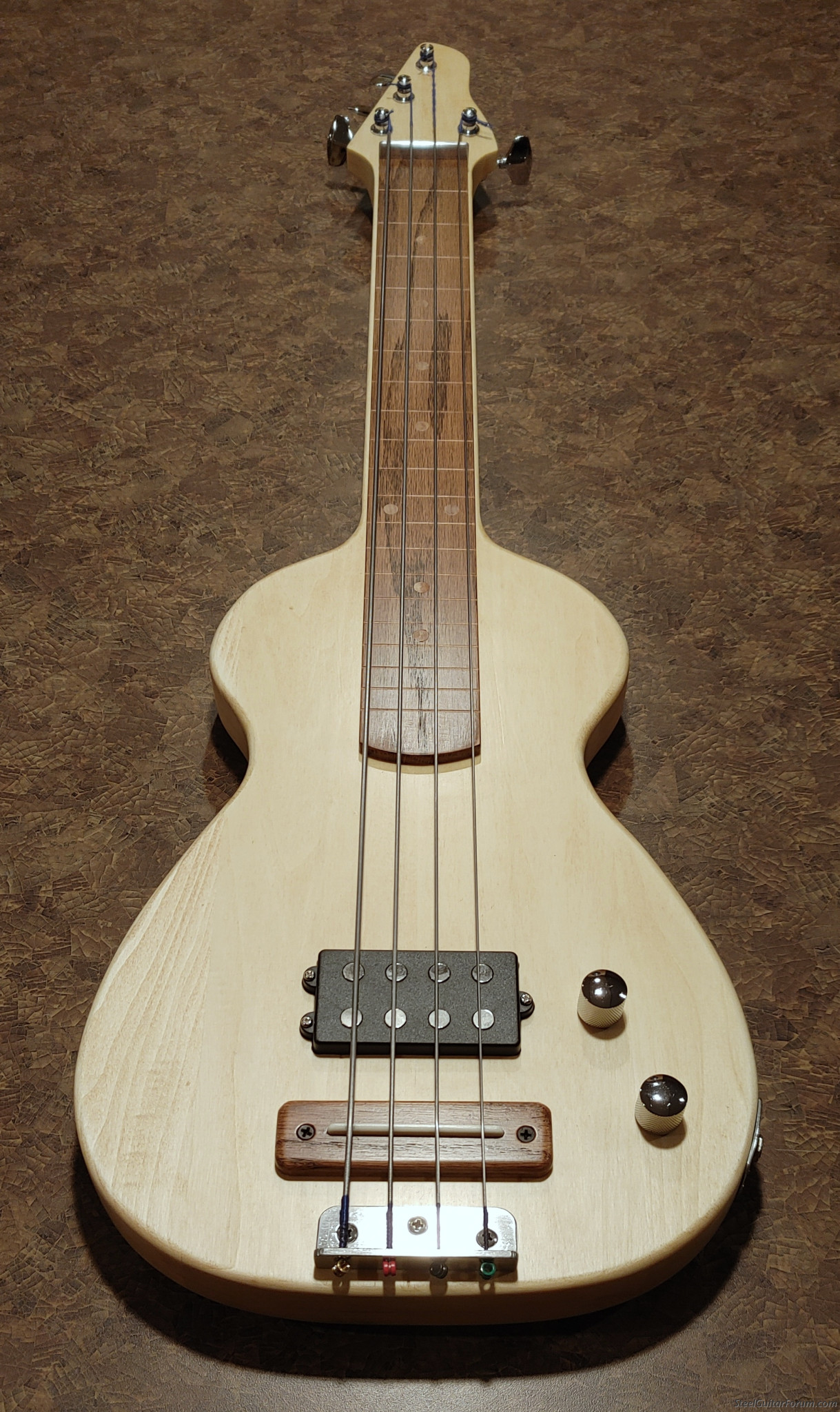Lap Steel Scale Length Comparisons
Moderator: Brad Bechtel
-
Rob DiStefano

- Posts: 63
- Joined: 21 May 2021 9:21 am
- Location: New Jersey, USA
Lap Steel Scale Length Comparisons
In y'all opinions, what -if any- are your personal advantages and disadvantages for a particular lap steel's scale length?
What scale length suits the music you wish to create best, and why?
What scale length suits the music you wish to create best, and why?
-
Jack Hanson

- Posts: 5518
- Joined: 19 Jun 2012 3:42 pm
- Location: San Luis Valley, USA
Personally, I prefer a 22.5" scale, since I mainly play 6th tunings and do lotsa bar slants. I find that a longer scale makes slants more difficult, especially in the lower registers. With the shorter scales, one can get away with heavier gauged strings, which to my ears sound better than skinny ones.
Resos and Weisses are an entirely different can'o'worms, however. On mine, I use straight major triad tunings (D, G, & A), and not nearly as many bar slants as on the electric, shorter-scaled 6th-tuned lap steels.
Resos and Weisses are an entirely different can'o'worms, however. On mine, I use straight major triad tunings (D, G, & A), and not nearly as many bar slants as on the electric, shorter-scaled 6th-tuned lap steels.
-
Mark Mansueto

- Posts: 644
- Joined: 21 Dec 2007 9:30 am
- Location: Michigan, USA
-
Bill Sinclair

- Posts: 1636
- Joined: 23 Apr 2014 7:39 am
- Location: Waynesboro, PA, USA
I agree with Mark's assessment. I'll add that, for me, harmonics come easier with a longer scale, for the same reason that intonation is easier. You don't have to be as "dead on" as the shorter scales. That said, all my gigging guitars at this time are 22.5". My left hand tends to cramp up on the lower register slants with the long scale.
-
Peter Jacobs

- Posts: 1018
- Joined: 4 Aug 1998 11:00 pm
- Location: Northern Virginia
Hey, Rob - My steels have 22.5 or 23” scales, so that’s just what I’m used to. It makes behind the bar pulls easy (my accuracy with them is another story…). But I’m comfortable on reso, with a 25” scale, so I don’t really think about it. String spacing is a bigger deal for me - I prefer a little narrower for speed and accuracy
-
Mark Mansueto

- Posts: 644
- Joined: 21 Dec 2007 9:30 am
- Location: Michigan, USA
Peter, that's interesting because I'm the opposite in that I like my spacing a bit wider. I have trouble with the end of my fingerpick hitting the far string on the upstroke when the spacing is too close.Peter Jacobs wrote:Hey, Rob - My steels have 22.5 or 23” scales, so that’s just what I’m used to. It makes behind the bar pulls easy (my accuracy with them is another story…). But I’m comfortable on reso, with a 25” scale, so I don’t really think about it. String spacing is a bigger deal for me - I prefer a little narrower for speed and accuracy
-
Peter Jacobs

- Posts: 1018
- Joined: 4 Aug 1998 11:00 pm
- Location: Northern Virginia
-
Mike Neer

- Posts: 11468
- Joined: 9 Dec 2002 1:01 am
- Location: NJ
I like a variety of scale lengths and string specing. There are things I can do on each guitar that I can’t replicate on the others, and so that is a good reason to have a few of them around.  . But my real preference is for long scale.
. But my real preference is for long scale.
Links to streaming music, websites, YouTube: Links
-
Bill McCloskey

- Posts: 8343
- Joined: 5 Jan 2005 1:01 am
- Location: Nanuet, NY
-
Jeff Mead

- Posts: 1712
- Joined: 15 Jun 2006 12:01 am
- Location: London, England
I agree apart from the tension part.Mark Mansueto wrote:The pros of shorter scale:
- slants are easier
- guitar is physically smaller
The pros of longer scale:
- easier to intonate notes
- increased tension has snappier tone
I'm sure there are more. these are just what I notice.
Using heavier strings on a short scale instrument will enable you to match the tension of the long scale one.
It's physics.
-
Carey Hofer
- Posts: 162
- Joined: 12 Aug 2021 1:18 pm
- Location: South Dakota, USA
I play on a Melbert 8 string, 23 1/4" scale, (B11th tuning- B C#, D#, F#, A, C#, E, G#, low to high) with a a G# on the first string. That string can sound a little thin if I'm not careful. I use an .011 it but I am going to try using as big a string as I can on that string til it starts breaking. Maybe I can get by with an .012. Seems like a bigger string especially on the higher strings, just sounds a little bigger and less tinny.
Am I wrong or isn't a general rule of thumb, the longer your scale is, the bigger strings you can use? For instance, bass guitars with say, 34" scales have huge strings.
Am I wrong or isn't a general rule of thumb, the longer your scale is, the bigger strings you can use? For instance, bass guitars with say, 34" scales have huge strings.
-
Rob DiStefano

- Posts: 63
- Joined: 21 May 2021 9:21 am
- Location: New Jersey, USA
The longer the scale, the smaller the string gauge needs to be. Short scale lengths usually require much heavier strings since they lack the length to get up to playing tension.Carey Hofer wrote:I play on a Melbert 8 string, 23 1/4" scale, (B11th tuning- B C#, D#, F#, A, C#, E, G#, low to high) with a a G# on the first string. That string can sound a little thin if I'm not careful. I use an .011 it but I am going to try using as big a string as I can on that string til it starts breaking. Maybe I can get by with an .012. Seems like a bigger string especially on the higher strings, just sounds a little bigger and less tinny.
Am I wrong or isn't a general rule of thumb, the longer your scale is, the bigger strings you can use? For instance, bass guitars with say, 34" scales have huge strings.
I have a few 23-1/8" scale lap steels, a 6 and an 8, both for C6. The 6 is perfect with Scotty's C6 strings; .036-.015 ... whereas the 8 required a bit of juggling with Scotty's C6 strings in the middle and a .046 for the bass and .011 for the treble. That .011 is on the small side and I need to try a .012 like with yours.
-
Carey Hofer
- Posts: 162
- Joined: 12 Aug 2021 1:18 pm
- Location: South Dakota, USA
-
Tom Wolverton

- Posts: 2922
- Joined: 8 May 2008 3:52 pm
- Location: Carpinteria, CA
-
Allan Revich

- Posts: 1249
- Joined: 2 Nov 2018 7:04 pm
- Location: Victoria, BC
Longer scale lengths facilitate lower tunings, using comfortable string gauges. 26” to 28” would be typical for a baritone.
Shorter scale lengths are also great for keeping instrument size more compact. I actually have a ukulele lap steel. Four strings. 19 inch scale length. Built to be tuned in open D, D F# A D.
Shorter scale lengths are also great for keeping instrument size more compact. I actually have a ukulele lap steel. Four strings. 19 inch scale length. Built to be tuned in open D, D F# A D.
 [/img]
[/img]